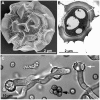Aspergillus fumigatus--what makes the species a ubiquitous human fungal pathogen?
- PMID: 24348239
- PMCID: PMC3857757
- DOI: 10.1371/journal.ppat.1003743
Aspergillus fumigatus--what makes the species a ubiquitous human fungal pathogen?
Conflict of interest statement
The authors have declared that no competing interests exist.
Figures


References
-
- Kwon-Chung KJ, Bennett JE (1992) Medical mycology. Philadelphia: Lea & Febiger. 823 p.
-
- Latgé J-P (2001) The pathobiology of Aspergillus fumigatus . Trends Microbiol 9: 382–389. - PubMed
-
- Brakhage AA, Langfelder K (2002) Menacing mold: the molecular biology of Aspergillus fumigatus . Annu Rev Microbiol 56: 433–455. - PubMed
Publication types
MeSH terms
Grants and funding
LinkOut - more resources
Full Text Sources
Other Literature Sources
Medical

